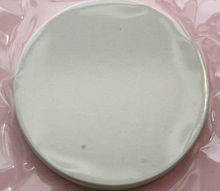Barium titanate
| Crystal structure | |||||||||||||||||||
|---|---|---|---|---|---|---|---|---|---|---|---|---|---|---|---|---|---|---|---|

|
|||||||||||||||||||
| __ Ba 2+ __ Ti 4+ __ O 2− | |||||||||||||||||||
| General | |||||||||||||||||||
| Surname | Barium titanate | ||||||||||||||||||
| other names |
Barium titanate (IV) |
||||||||||||||||||
| Ratio formula | BaTiO 3 | ||||||||||||||||||
| Brief description |
white to gray, odorless powder |
||||||||||||||||||
| External identifiers / databases | |||||||||||||||||||
|
|||||||||||||||||||
| properties | |||||||||||||||||||
| Molar mass | 233.19 g mol −1 | ||||||||||||||||||
| Physical state |
firmly |
||||||||||||||||||
| density |
5.85 g cm −3 |
||||||||||||||||||
| Melting point |
1620 ° C |
||||||||||||||||||
| solubility |
almost insoluble in water |
||||||||||||||||||
| safety instructions | |||||||||||||||||||
|
|||||||||||||||||||
| MAK |
0.5 mg m −3 barium |
||||||||||||||||||
| As far as possible and customary, SI units are used. Unless otherwise noted, the data given apply to standard conditions . | |||||||||||||||||||
Barium titanate is a mixed oxide of barium and titanium from the group of titanates and crystallizes in the perovskite structure.
Extraction and presentation
BaTiO 3 can be produced using the classic mixed oxide method from BaCO 3 ( barium carbonate ) and TiO 2 ( titanium dioxide ) in a solid-state reaction, known as calcination , at a temperature of 1200 ° C.
Crystallization from molten solution offers more moderate conditions. Stoichiometric amounts of barium carbonate and titanium dioxide ( anatase ) are mixed with a large excess of sodium chloride or covered with potassium fluoride . The barium titanate crystallizes out in the furnace at 1000 to 1160 ° C. After washing out the salt residues, it is obtained in a very pure form, in fine crystals.
If the reaction is carried out in a platinum crucible in a melt of potassium fluoride at 1160 ° C. using commercially available powdered barium titanate, pronounced single crystals of the compound are obtained, which are sometimes twinned .
Physical Properties
Barium titanate belongs to the group of electroceramics . Barium titanate is a ferroelectric and has a pronounced hysteresis loop . Like all ferroelectrics, it has a high permittivity , which strongly depends on the electrical field strength .
Barium titanate crystallizes in two polymorphic lattice types, the hexagonal lattice type and the perovskite structure. At temperatures below 120 ° C it is a tetragonally distorted modification of the perovskite structure with the lattice constants a = 399.2 pm and c = 403.6 pm, in which the titanium ion is shifted in the z-direction compared to the oxygen ions. This results in a dipole moment of the unit cell and the polarization. When the Curie temperature of 120 ° C is reached, the phase transition to the cubic perovskite structure takes place, in which the titanium ion is located exactly in the center of the octahedron of oxygen ions. This means that the unit cell of the crystal no longer has a dipole moment and the crystal is no longer ferroelectric. At high temperatures, the phase transition into the hexagonal phase takes place. This phase change requires a more extensive rearrangement of the ions than the transition at 120 ° C. In the case of larger crystals it often happens that they break during this transformation.
Below 0 ° C there is an orthorhombic symmetry , while below -90 ° C it changes into a trigonal one.
use
Due to its ferroelectric, dielectric and pyroelectric properties, barium titanate and related perovskites such as Pb (Zr, Ti) O 3 are used as materials in electronics and sensor technology, among other things. Examples are PTC thermistors and their use as a non-linear dielectric in high-capacity ceramic capacitors . However, the specific capacitance value fluctuates greatly and depends, among other things, on the voltage applied to the capacitor and the temperature.
literature
- Arthur R. von Hippel : Ferroelectricity, Domain Structure, and Phase Transitions of Barium Titanate . In: Rev. Mod. Phys. 1950, 22, pp. 221-237, doi : 10.1103 / RevModPhys.22.221 .
Web links
Individual evidence
- ↑ a b c d e data sheet barium titanate from AlfaAesar, accessed on January 7, 2010 ( PDF )(JavaScript required) .
- ↑ Entry on barium titanate in the GESTIS substance database of the IFA , accessed on July 27, 2019(JavaScript required) .
- ↑ Not explicitly listed in Regulation (EC) No. 1272/2008 (CLP) , but with the indicated labeling it falls under the group entry barium salts, with the exception of barium sulphate, salts of 1-azo-2-hydroxynaphthalenyl aryl sulphonic acid, and of salts specified elsewhere in this Annex in the Classification and Labeling Inventory of the European Chemicals Agency (ECHA), accessed on February 1, 2016. Manufacturers or distributors can expand the harmonized classification and labeling .
- ↑ Data sheet barium titanate from Sigma-Aldrich , accessed on March 9, 2011 ( PDF ).
- ↑ a b c d e Francis S. Galasso: Barium titanate, BaTiO 3 (Barium titanium (IV) oxide) . In: Aaron Wold and John K. Ruff (Eds.): Inorganic Syntheses . tape 14 . McGraw-Hill Book Company, Inc., 1973, ISBN 07-071320-0 ( defective ) , p. 142-143 (English).


